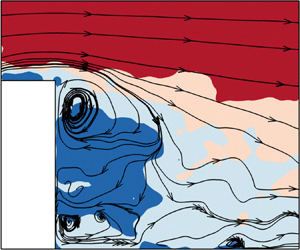Article contents
Time-resolved wake dynamics of finite wall-mounted circular cylinders submerged in a turbulent boundary layer
Published online by Cambridge University Press: 21 April 2021
Abstract

The unsteady flow separation and wake dynamics around finite wall-mounted circular cylinders fully immersed in a turbulent boundary layer (TBL) are investigated experimentally using a time-resolved particle image velocimetry (TR-PIV) system. The cylinder aspect ratios (h/d = 0.7–7.0, where h and d are the height and diameter of the cylinder, respectively) and the relative boundary layer thickness (δ/d = 8.7, where δ is the boundary layer thickness) were chosen to systematically investigate the effects of submergence ratio (δ/h = 1.2–12.4) using δ/h values much larger than that reported in the literature. With δ/h > 1.0, the cylinders encountered elevated turbulence levels (4%–10 %), reduced mean velocity and strong mean shear in the approach TBL which had profound effects on the attachment length and flapping motion of the reverse-flow region on the top surface of the cylinders. The time-averaged statistics including the mean velocities, Reynolds stresses and production terms were used to characterize the flow field and the large-scale anisotropy. The results showed that the wake structure of the submerged cylinders can be divided into dipoles and quadruples with a critical h/d = 3.5 and δ/h = 2.5. Both categories exhibited strong anisotropy, but the quadruples showed an interesting pattern where the streamwise Reynolds normal stress is less than the other components due to negative production in the wake region. Spectral analysis and joint-probability density functions are used to show that the reverse-flow region behind the cylinder is characterized by low-frequency flapping motions with a Strouhal number that decreases with increasing aspect ratio. The spatio-temporal evolution of the vortices also revealed the occurrence of cellular shedding behaviour where the vortices near the free end are shed discretely while those in the lower span are shed in the form of long streaky structures.
Information
- Type
- JFM Papers
- Information
- Copyright
- © The Author(s), 2021. Published by Cambridge University Press
References
- 51
- Cited by


